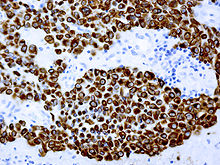- Crooke-Zelle
-
Als Crooke-Zellen werden hyalinisierte basophile Zellen der Adenohypophyse bezeichnet, die von dem englischen Endokrinologen Arthur Carleton Crooke (1905–1990) erstmals beschrieben wurden.[1] Charakteristisch ist auch die ringförmige Einlagerung von Zytokeratinen.[2][3]
Crooke-Zellen stellen sekundäre regressive Veränderungen ACTH-produzierender Zellen der Adenohypophyse bei Hyperkortisolismus dar und werden typischerweise beim Cushing-Syndrom, aber auch nach medikamentöser Kortisongabe im nichtneoplastischen adenohypophysealen Gewebe beobachtet.
Hiervon abzugrenzen ist das sogenannte Crooke-Zelladenom, eine seltene Variante des ACTH-Zelladenoms, dessen Tumorzellen die Morphologie von Crooke-Zellen aufweisen.[2]
Einzelnachweise
- ↑ Crooke: A change in the basophile cells of the pituitary gland common to conditions which exhibit the syndrome attributed to basophile adenoma. J Pathol 1935;41: 339-349.
- ↑ a b George et al.: Crooke's cell adenoma of the pituitary: an aggressive variant of corticotroph adenoma. Am J Surg Pathol. 2003 Oct;27(10):1330-6. PMID 14508394
- ↑ Eschbacher & Coons: Cytokeratin CK20 is a sensitive marker for Crooke's cells and the early cytoskeletal changes associated with hypercortisolism within pituitary corticotrophs. Endocr Pathol. 2006;17(4):365-76. PMID 17525485
Wikimedia Foundation.


